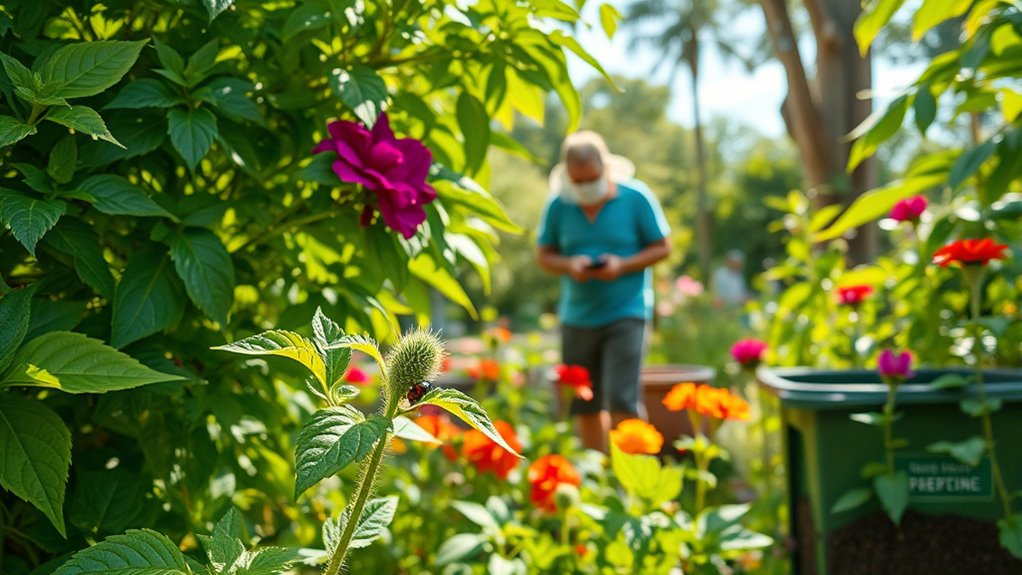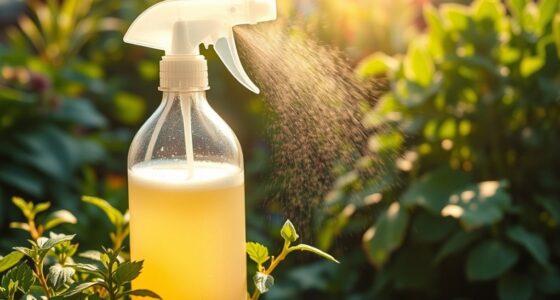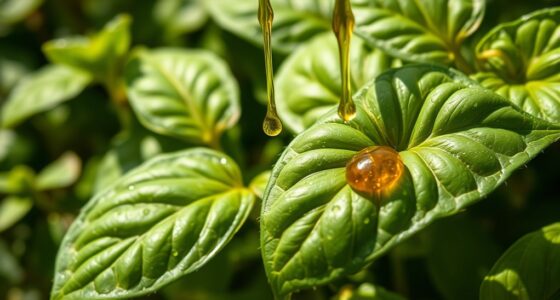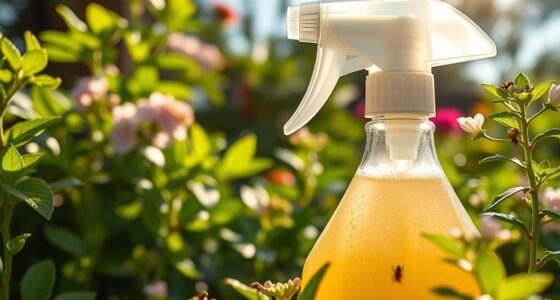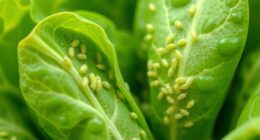Integrated Pest Management (IPM) is a sustainable approach that helps you control pests in your garden while minimizing environmental impact. It combines regular pest monitoring, biological controls like beneficial insects, and cultural practices such as crop rotation and proper watering. By managing pest levels rather than eradicating them completely, you encourage healthy plants and reduce chemical use. Keep exploring to discover how these strategies work together for a healthier, eco-friendly garden.
Key Takeaways
- IPM combines multiple pest control strategies to keep pest levels manageable while minimizing environmental impact.
- Regular pest monitoring helps detect issues early and reduces unnecessary pesticide use.
- Biological controls utilize natural enemies like beneficial insects to reduce pest populations sustainably.
- Cultural and mechanical practices, such as crop rotation and handpicking, help prevent pest infestations naturally.
- IPM promotes healthier plants, biodiversity, and eco-friendly pest management through ongoing observation and integrated methods.

If you’re looking for an effective way to control pests in your garden without relying solely on chemicals, integrated pest management (IPM) offers a sustainable solution. IPM focuses on combining different strategies to keep pest populations at manageable levels while minimizing environmental impact. One of the key aspects of IPM is understanding your garden’s specific pest problems through pest monitoring. This involves regularly inspecting your plants for signs of pests or damage, so you can detect issues early before they become severe. Pest monitoring helps you make informed decisions, ensuring you only take action when necessary, reducing the chances of unnecessary pesticide use.
Regular pest monitoring enables early detection and informed, eco-friendly pest control decisions.
Another essential element of IPM is utilizing biological controls. These are natural enemies of pests, such as beneficial insects, predators, or pathogens that naturally reduce pest populations. Introducing or encouraging these biological controls in your garden can help keep pests in check without harming beneficial insects or pollinators. For instance, releasing ladybugs to control aphids or using parasitic wasps to target specific pests are common biological control methods. By fostering a balanced ecosystem, you create an environment where pests are naturally kept under control, lessening your reliance on chemical interventions.
Integrated pest management also emphasizes cultural practices, like crop rotation, selecting pest-resistant plants, and proper watering and fertilizing techniques. These practices make your garden less inviting to pests and less conducive to their growth. Mechanical controls, such as handpicking pests or using traps, are also part of the IPM toolkit. They are simple, targeted methods that can markedly reduce pest numbers without harming other beneficial organisms.
Importantly, IPM isn’t about eliminating every pest but managing their populations to levels that won’t damage your plants or compromise your garden’s health. This approach requires patience and ongoing observation. By consistently monitoring pests and applying biological controls when needed, you create a resilient garden ecosystem. Additionally, understanding the HEPA filtration technology used in some pest control devices can help you choose supplementary tools that support pest management efforts indoors.
This method promotes healthier plants, reduces chemical runoff, and supports local biodiversity. In essence, IPM is about creating a balanced approach that combines pest monitoring, biological controls, and cultural practices. It empowers you to take proactive steps, reducing your dependence on pesticides and fostering a more sustainable, productive garden. When you integrate these strategies, you not only improve your garden’s health but also contribute to environmental conservation. So, by paying close attention to pest monitoring and harnessing natural controls, you’re taking meaningful steps toward eco-friendly pest management that benefits everyone.
Frequently Asked Questions
How Do I Start Implementing IPM in My Garden?
To start implementing IPM in your garden, first identify pests and monitor their activity regularly. Use companion planting to naturally repel pests and attract beneficial insects. Incorporate biological controls like ladybugs or nematodes to reduce pest populations without chemicals. Keep your garden healthy by practicing proper watering and soil management. This proactive approach helps you manage pests sustainably while supporting a vibrant, thriving garden.
Are There Organic Options Within IPM Strategies?
Think of IPM as a balanced orchestra, where organic methods and natural controls play harmony. Yes, you can definitely include organic options within IPM strategies. Using beneficial insects, companion planting, and organic pesticides helps you manage pests responsibly. These natural controls are eco-friendly, safe, and effective. They work together to keep your garden healthy without harsh chemicals, creating a sustainable environment where pests are kept in check naturally.
Can IPM Be Used for Large-Scale Farming?
You can definitely use IPM for large-scale farming, as it promotes sustainable agriculture by combining pest control methods that minimize chemical use. This approach helps you manage pests effectively while protecting the environment and your crops’ health. By integrating biological, cultural, and mechanical strategies, you reduce reliance on pesticides, making your farming operation more eco-friendly and resilient. It’s a practical, adaptable way to keep pests under control at any scale.
What Are Common Mistakes to Avoid With IPM?
You should avoid common IPM mistakes like neglecting pest identification and skipping monitoring techniques. If you misidentify pests, you might choose ineffective controls, wasting time and resources. Regularly monitoring your garden helps catch issues early. Also, don’t rely solely on chemical controls; integrate cultural and biological methods. By accurately identifying pests and maintaining diligent monitoring, you’ll improve your IPM strategies and keep your garden healthier.
How Effective Is IPM Compared to Chemical Pesticides?
You’ll find that IPM is more effective than chemical pesticides because it reduces pest resistance over time, preventing pests from becoming immune. It’s also more cost-effective, as you target pests precisely and avoid unnecessary chemical use. Instead of relying solely on pesticides, IPM combines methods, which offers long-term control and minimizes environmental impact. Overall, IPM provides sustainable, efficient pest management tailored to your garden’s needs.
Conclusion
By choosing integrated pest management, you protect your plants, preserve your garden’s health, and promote a thriving ecosystem. You reduce chemical use, encourage natural predators, and practice sustainable gardening. You become a responsible gardener, a mindful steward, and a confident decision-maker. Embrace IPM to nurture your garden, to support your environment, and to enjoy the beauty of healthy, balanced growth. With IPM, you create a garden that’s vibrant, resilient, and rewarding.
